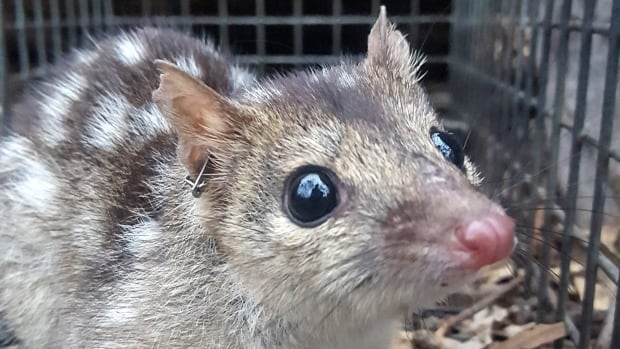As It Happens6:30These males critters use all their energy trying to mate, then promptly die of exhaustion
The life of a male northern quoll is short, brutish and driven almost entirely by the pursuit of sex.
The Australian male marsupials are what’s known as “suicidal reproducers,” which means they die after a single mating season, or about one year. The females, meanwhile, can live between two to four times as long.
The cause of this untimely demise was previously unknown. But now scientists believe they have the answer: sleep deprivation. The males seek mates at the expense of almost everything else — including food, hygiene and rest — propelling themselves into an early grave.
“Basically, they’re spending the entire day just running around looking for females, trying to mate with as many females as possible, fighting with other males,” Christopher Clemente, an animal ecophysiologist at Australia’s University of the Sunshine Coast, told As It Happens host Nil Köksal.
“And it’s this lack of sleep that seems to be degrading their bodies.”
The study — a joint effort by researchers at the University of the Sunshine Coast and the University of Queensland — was published Wednesday in the Royal Science Open Society journal.
A mating mystery
Suicidal reproduction — or semelparity — is not uncommon in the animal kingdom. There’s the female praying mantis, for example, which bites off the male’s head after sex and devours her mate’s body for nourishment. Or pacific salmon, which expend all their energy swimming upstream to spawn, only to die shortly after.
There are also several species of marsupials who exhibit semelparity. The male antechinus, like its quoll cousin, also dies after one mating season.
In the antechinus, scientists have linked this post-mating morbidity to a spike in stress hormones, which causes their immune systems to fail.
“So we thought, well, probably that’s what’s going on in quolls. But when we looked for the stress hormone, it wasn’t there,” Clemente said. “So it was a bit of a mystery as to why these quolls were actually dying.”
Lacking an internal explanation, the researchers decided to look for a behavioural one. They affixed tiny electronic backpacks to the cat-sized critters that tracked their movement and acceleration over time.
“We were able to use some machine learning to figure out what the accelerometer signal looked like when the animals were running, when the animals were climbing or when the animals were sleeping, so we could record how active they are and how much rest they were getting,” Clemente said.
The female quolls spent about 23 to 24 per cent of the day sleeping — “what we think is a normal amount of rest,” Clemente said. The males, by contrast, rested “very little” — about seven or eight per cent of the time.
The males also cover a lot of ground seeking mates. Two of the quolls in the study travelled about 10 kilometres in one night, which would be the equivalent of a human being walking between 35 to 40 kilometres.
The researchers did some digging into existing research about the effects of sleep deprivation on similar animals, namely rodents, and found “a whole pile of symptoms,” including aggression, weight loss and a lack of grooming behaviour.
“And all the symptoms that we saw in sleep deprived rodents are the same symptoms that we saw in the male quolls during the reproductive season, but not the female quolls,” he said.
‘They literally fall apart’
What’s more, the researchers found that celibate male northern quolls live two to three times longer than their sexually active peers.
One male in the study lost his testicles, possibly in a fight with another quoll. Lacking the drive to mate, it lived for several years.
“So it certainly seems to be this huge reproductive effort they’re putting in that’s actually causing their ultimate demise,” Clemente said.

So what does dying of sleep deprivation look like for a northern quoll? For one, they don’t groom enough, and become susceptible to parasitic infections. They’re also less vigilant in searching for food. Furthermore, their extreme exhaustion makes them excellent targets for predators and more likely to be struck by vehicles.
“But even without these things, they lose so much weight that eventually their condition just deteriorates to a point where they literally fall apart,” Clemente said.
Here for a good time, not a long time
What drives the males to such a self-destructive and single-minded pursuit of sex?
“The reason it happens is that the female quolls all become reproductively active, reproductively available, at the same time,” Clemente said.
The quolls, he says, feed on insects whose populations explode during the brief summer months.
“All this food drives the females to start their reproductive cycle,” Clemente said. “The males have decided: ‘Well, the best way for me to maximize my reproductive output would be to mate with as many females as possible in a really short period of time. ‘And that’s exactly what they’re doing.”
While the findings are interesting in their own right, Clemente says there’s a bigger goal to the work he and his colleagues are doing — conservation of the species.
“They are endangered in a lot of places in Australia due to things like habitat loss or embedded invasive species like dogs and foxes and cats,” he said of the northern quolls.
“If we could understand their performance and their behaviour, and how that is influenced by the different habitats that we find them in, perhaps we can figure out which habitats are most valuable for their survival. And in doing so, really help the conservation efforts to this species.”


